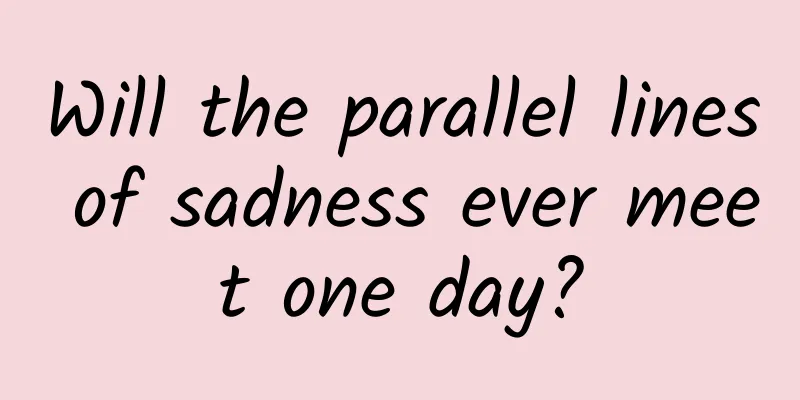Will the parallel lines of sadness ever meet one day?

|
When it comes to parallel lines, everyone is familiar with them - two parallel sections of railroad tracks, black and white zebra crossings, these are parallel lines that can be observed in life. In literary works, we also see such descriptions: "Two people are like parallel lines, and they never intersect." In our impression, parallel lines have the property of never intersecting. But some people say: "Parallel lines intersect at one point at infinity." Do parallel lines intersect at any point? Will they meet at infinity? Figure 1 Parallel rails (Image source: Baidu Encyclopedia) To understand this problem, we need to first understand where the saying that parallel lines never intersect comes from. Parallel lines are born from the fifth axiom of plane geometry When studying geometry, Euclid, an ancient Greek mathematician and the father of geometry, discovered that some geometric knowledge was proven to be correct through long-term and repeated human practice and did not need to be deduced from other knowledge. Therefore, Euclid gave five axioms in "Elements of Geometry" [1] and built a geometry system based on them. These five axioms are: Axiom 1: A straight line can be drawn from any point to any other point Axiom 2: A finite line segment can be extended Axiom 3: A circle can be drawn with any point as the center and any distance Axiom 4: All right angles are equal Axiom 5: If a straight line intersects two other straight lines in the same plane, and the sum of the two interior angles on one side is less than the sum of the two right angles, then the two straight lines will intersect on this side after being infinitely extended. Among the five axioms, the first four seem to be relatively concise and clear, while the fifth axiom is relatively long-winded. Later research and derivation showed that the fifth axiom is equivalent to the following two statements: one is that the sum of the interior angles of a triangle is 180 degrees; the other is that through a point outside a straight line, there is only one straight line that does not intersect the straight line. The two lines that never intersect in the second statement are called parallel lines. This is the reason why the statement that parallel lines never intersect comes into being. And because the fifth axiom is related to parallelism, this axiom is also called the parallel axiom. Non-Euclidean geometry vs. the parallel axiom Ever since the fifth axiom of plane geometry was proposed, mathematicians have begun to think about a question: Can this axiom be replaced by other axioms? In the 19th century, Gauss, Bachevsky, Bolyai and others independently tried to use different parallel axioms. Eventually, two new geometric systems, Lobachevsky geometry and Riemann geometry, were formed based on how many lines can be drawn through a point outside a line and are parallel to a known line. Because these two systems are different from Euclidean geometry, they are collectively called "non-Euclidean geometry". Lobachevsky geometry, abbreviated as Lobachevsky geometry, holds that at least two lines can be drawn through a point outside a straight line that are parallel to the known straight line. Figure 2 Lobachevsky geometry (Source: Baidu Image) The hyperbolic surface shown in Figure 2 vividly demonstrates this situation. On a hyperbolic surface, due to the curvature of space, several straight lines parallel to the known straight line can be drawn through a point outside the straight line. Because this geometry describes the situation in hyperbolic space, it is also called "hyperbolic geometry". In such a hyperbolic space, through a point outside a straight line, you can make multiple lines parallel to the known straight line. In addition, if you make any triangle in the hyperbolic space, the sum of the interior angles of the triangle is less than the sum of the interior angles in plane geometry (180°). Riemannian geometry assumes that there is no line parallel to a given line through a point outside the line. Lobachevsky geometry considers the geometry of hyperbolic surfaces, while Riemannian geometry considers the geometry of elliptical spaces. Therefore, Riemannian geometry is also called "elliptic geometry". Figure 3 Riemannian geometry (Image source: Baidu Image) Figure 3 vividly illustrates the characteristics of Riemannian geometry. In an elliptical space, the sum of the interior angles of a triangle is less than 180 degrees. And because all straight lines in an elliptical space pass through the infinite point at the top of the elliptical space, it is impossible to draw a parallel line to a known straight line through a point outside the straight line. This is also the origin of the saying that "parallel lines intersect at infinity". In fact, according to the definition of geometry, when we use Riemannian geometry to study problems, all straight lines intersect at infinity, and the concept of parallel lines does not exist, because in the mathematical definition, parallel lines must be straight lines that never intersect in the same plane. From this perspective, "parallel lines intersect at infinity" is a false mathematical proposition, but it has certain artistic value. What is the application value of non-Euclidean geometry? Plane geometry has great application value in our real life. From mechanical manufacturing to geographic information measurement, plane geometry calculations are indispensable. This is why we learn plane geometry from childhood to adulthood. So is non-Euclidean geometry something that mathematicians came up with out of nowhere? Does non-Euclidean geometry have any application value? The answer is yes. Non-Euclidean geometry has high application value in specific spaces and specific problems. From the above we can see that non-Euclidean geometry is mainly used to study geometric problems in hyperbolic space and elliptic space, two non-planar spaces. Non-planar spaces are also widely present in our real life. There are two most common situations in which non-planar space appears: The first case is the distortion of space caused by massive celestial bodies. According to the theory of general relativity, space will bend significantly near a massive celestial body. In daily life, we will find that if we put a heavy ball on a propped-up cloth, the heavy ball will bend the cloth. In the universe, massive celestial bodies are the heavy balls that produce pressure, and the space structure is the supported cloth. Finally, as shown in Figure 4, a certain space curvature will be generated around the massive celestial bodies. Figure 4 Massive celestial bodies produce obvious space curvature (Image source: Baijiahao) When traveling in such a curved space, the knowledge of plane geometry is no longer applicable, but non-Euclidean geometry comes into play. The space curvature produced by a single celestial body is close to an ellipsoid, while multiple celestial bodies may produce a curved space close to a hyperbolic surface in the boundary area. If humans ever set out to explore the vast sea of stars in the universe, calculating the geometric relationships in curved space based on non-Euclidean geometry will be an essential technology for achieving space travel. The second type of non-planar space is that the living plane itself has negligible curvature. The Earth we live on is actually an ellipsoid. When we observe the Earth from space, we can easily find that the Earth's surface is curved. At this time, the geometric relationship in the Earth can be analyzed through spatial solid plane geometry. However, if we only observe on the earth and cannot obtain the perspective from space, then the geometric relationship in the two-dimensional space on the earth's surface actually conforms to the relevant properties of elliptical geometry. Based on this characteristic of the earth's surface, Riemannian geometry can be used to measure the earth's surface. Through the study of geodesics on the earth's surface based on Riemannian geometry, the discipline of "geodesic geometry" was established. Therefore, when studying geographic information, aviation and navigation and other issues on the earth's surface, Riemannian geometry in non-Euclidean geometry has a very high application value. Finally, back to our original question, the mathematical definition of parallel lines is that there is no intersection, and parallel lines will not meet at infinity. It is just that in Riemannian geometry, two seemingly "parallel" straight lines will meet at infinity, but they are not actually parallel lines. Although parallel lines are destined not to meet, the study of parallel lines and the fifth axiom of plane geometry has produced non-Euclidean geometry such as Lobachevsky geometry and Riemann geometry, which have been widely used in various fields. Mathematical research is often like this, and seemingly "useless" ideas that seem to be fantastic end up finding wonderful uses in real life. References: [1] Euclid, Lan Jizheng, Zhu Enkuan. Euclid’s Elements[M]. Shaanxi Science and Technology Press, 2003. Author: Canteen Science Popularization Produced by: Science Popularization China Producer: China Science Expo |
<<: 2 plums equal 1 gram of salt. It turns out there is so much "invisible salt" in our lives!
>>: Really! Buy one get one free! Diamond World's "Matryoshka" is here
Recommend
How do educational and training institutions attract new customers online?
On May 27, I was invited by a teacher from an edu...
I want to learn Baidu bidding promotion. Are there any recommended Baidu bidding promotion tutorials?
The most taboo for novices learning Baidu bidding...
Google may disable fast charging technologies such as Qualcomm and MediaTek in future Android versions
According to a report by Android central, a well-...
How to use ROI data to increase downloads and purchase conversions?
In the first half, traffic acquisition is used to...
Honor V20: Not only the most affordable Kirin 980, but also a flagship phone with comprehensive quality
At the end of the year, when people all over the ...
Transposition, flyby... Common terminology in manned space flight, help you learn about spacecraft thermal knowledge!
Parking, maneuvering, and flying around... Friend...
What benefits will veterans receive in 2022? Is there a pension?
In July 2020, the Ministry of Veterans Affairs an...
[Case] How did Tmall’s 618 Fans Carnival get fans excited step by step?
Tmall launched a new concept of the 618 festival ...
Download link of "Su Mang: Live a Beautiful Life | A Smart Way for Women to Live a Life without Hardship or Tiredness"
Download link of "Su Mang: Live a Beautiful ...
How to use oseltamivir, the "miracle drug" for influenza A, correctly?
Recently, influenza A virus infection has spread ...
Emergency Science Popularization: It concerns thousands of households! You must master these gas safety knowledge
Safety first, the alarm bell is always ringing Pr...
Who was the richest student of Confucius? Without him, there would be no Analects!
Mixed Knowledge Specially designed to cure confus...
The Four Color Theorem: A New-Age Algorithm for the Classical Coloring Problem
You must have heard of the Four Color Theorem, wh...
Building a simple logistic regression model from scratch using TensorFlow
TensorFlow is a Python-based machine learning fram...
1/2.4 inch phase focus depth analysis Sony IMX230
Sony's Exmor RS series products are no strang...









